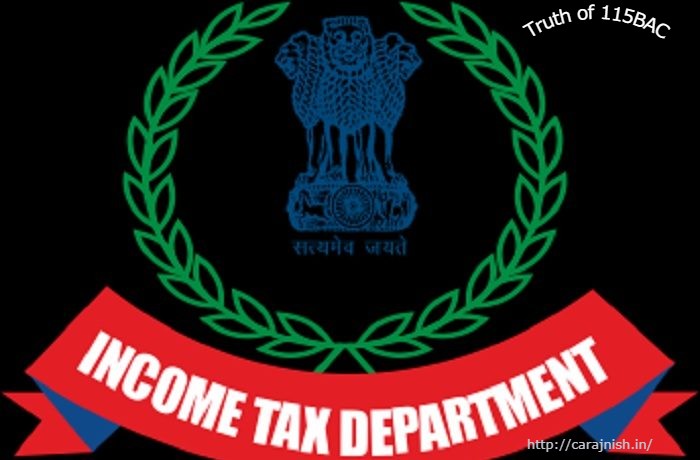Budget
The Budget 2020 has invented a new tax regime for the individuals and HUFs. Under this regime, a new section is inserted which provides an option for the tax payers to opt a new slab other than slab mentioned in the schedule. Opting to the new tax rate under new section is subject to the certain conditions. The condition is that the person opting for the regime has to forego certain exemptions and deductions.
The Finance minister in her budget speech highlighted that tax burden on a person earning Rs. 15 lakhs shall be reduced by Rs. 78,000. However, this situation will rarely arise as a tax saving of Rs. 78,000 arises only when the assessee has not been availing any exemption or deduction in the current regime. We have analysed the following situation to understand the implications of this new tax regime:
| Deduction available in the current tax regime | Breakeven point | When it is beneficial to opt for new regime of Section 115BAC? | Reference |
| No deduction is allowable | – | Yes | Note 1 |
| Deduction allowable under Section 80C | 8,50,000 | Income in excess of Breakeven | Note 2 |
| Deduction allowable under: – Sections 80C – Section 80D | 12,25,000 | Income in excess of Breakeven | Note 3 |
| Deduction allowable under: – Sections 80C – Section 80D – Section 16 (Standard Deduction) | 15,00,000 | Never | Note 4 |
| Deduction allowable under: – Sections 80C – Section 80D – Section 16 (Standard Deduction) – Section 24 (Interest on housing loan) | – | Never | Note 5 |
Table 1: Individual not eligible for any deduction
| Income | Tax liability under New regime | Tax liability under Old regime | Net tax saving |
| 6,00,000 | 23,400 | 33,800 | 10,400 |
| 7,00,000 | 33,800 | 54,600 | 20,800 |
| 8,00,000 | 46,800 | 75,400 | 28,600 |
| 9,00,000 | 62,400 | 96,200 | 33,800 |
| 10,00,000 | 78,000 | 1,17,000 | 39,000 |
| 11,00,000 | 98,800 | 1,48,200 | 49,400 |
| 12,00,000 | 1,19,600 | 1,79,400 | 59,800 |
| 13,00,000 | 1,43,000 | 2,10,600 | 67,600 |
| 14,00,000 | 1,69,000 | 2,41,800 | 72,800 |
| 15,00,000 | 1,95,000 | 2,73,000 | 78,000 |
Table 2: Individual eligible for deduction under section 80C
| Income | Tax liability under New regime | Tax liability under Old regime | Net tax saving |
| 6,00,000 | 23,400 | – | -23,400 |
| 7,00,000 | 33,800 | 23,400 | -10,400 |
| 8,00,000 | 46,800 | 44,200 | -2,600 |
| 9,00,000 | 62,400 | 65,000 | 2,600 |
| 10,00,000 | 78,000 | 85,800 | 7,800 |
Table 3: Assessee is eligible for deduction under sections 80C and 80D
| Tax liability under New regime | Tax liability under Old regime | Net tax saving |
| 23,400 | – | -23,400 |
| 33,800 | – | -33,800 |
| 46,800 | 33,800 | -13,000 |
| 62,400 | 54,600 | -7,800 |
| 78,000 | 75,400 | -2,600 |
| 98,800 | 96,200 | -2,600 |
| 1,19,600 | 1,17,000 | -2,600 |
| 1,25,840 | 1,26,360 | 520 |
| 1,27,920 | 1,29,480 | 1,560 |
| 1,30,000 | 1,32,600 | 2,600 |
Table 4: Assessee is eligible for deduction under section 80C and 80D and standard deduction under section 16
| Income | Tax liability under New regime | Tax liability under Old regime | Net Tax Saving |
| 6,00,000 | 23,400 | – | -23,400 |
| 7,00,000 | 33,800 | – | -33,800 |
| 8,00,000 | 46,800 | 23,400 | -23,400 |
| 9,00,000 | 62,400 | 44,200 | -18,200 |
| 10,00,000 | 78,000 | 65,000 | -13,000 |
| 14,00,000 | 1,69,000 | 1,63,800 | -5,200 |
| 15,00,000 | 1,95,000 | 1,95,000 | – |
| 16,00,000 | 2,26,200 | 2,26,200 | – |
Table 5: Assessee is eligible for deduction under section 80C and 80D, standard deduction under section 16 and deduction for interest on housing loan under section 24(b)
| Income | Tax liability under New regime | Tax liability under Old regime | Net Tax Saving |
| 6,00,000 | 23,400 | – | -23,400 |
| 7,00,000 | 33,800 | – | -33,800 |
| 8,00,000 | 46,800 | – | -46,800 |
| 9,00,000 | 62,400 | – | -62,400 |
| 10,00,000 | 78,000 | 23,400 | -54,600 |
| 12,00,000 | 1,19,600 | 65,000 | -54,600 |
| 14,00,000 | 1,69,000 | 1,06,600 | -62,400 |
| 15,00,000 | 1,95,000 | 1,32,600 | -62,400 |
| 17,00,000 | 2,57,400 | 1,95,000 | -62,400 |
Other Key decisions from Budget-2020: Corporate Law perspective
Following are the keyways from Finance Bill and Budget Speech, 2020 related to corporate and allied laws.
1. Govt. proposes to exempt levy of stamp duty on transactions in stock exchanges established in IFSCs
The Finance Bill, 2020 proposes to exempt levy of stamp duty in respect of instruments of transaction in stock exchanges and depositories established in IFSC set up under SEZ Act, 2005. In order to give effect to the proposed amendment, a new proviso has been proposed to be inserted to Section 9A (2) of the Indian Stamp Act, 1899.
The exemption of the stamp duty on transactions carried out on stock exchanges and depositories established in IFSCs will lower the transactions cost and would encourage investments in IFSCs.
Last year, in Finance Budget, 2019 the Govt. had inserted Section 9A to the Indian Stamp Act, 1899 whereby it was proposed to consolidate the stamp duty provisions relating to issue, sale or transfer of securities under the newly inserted section 9A and 9B of the Indian Stamp Act, 1899. The Amendment Act also proposed a uniform system for collection and payment of stamp duty on the issue and transfer of securities.
2. Deposit Insurance Coverage limit to be increased From Rs. 1 Lakh to Rs. 5 Lakh per depositor
The Finance Minister in her budget speech has assured depositors’ that there money is absolutely safe with scheduled bank. She said that robust mechanism is in place to monitor the health of all Scheduled Commercial Banks. Further, she announced that the Deposit Insurance and Credit Guarantee Corporation (DICGC) has been permitted to increase Deposit Insurance Coverage for a depositor, which is now Rs 1 lakh to Rs. 5 lakh per depositor.
Meaning of Insurance deposit– As per Section 2(j) “insured deposit” means the deposit or any portion thereof the repayment whereof is insured by the Deposit Insurance and Credit Guarantee Corporation under the provisions of the Deposit Insurance and Credit Guarantee Corporation Act, 1961
3. Eligibility limit for NBFCs for debt recovery under SARFAESI Act to be reduced to loan size of Rs. 50 Lakh.
The FM in the budget speech has announced that the limit for NBFCs to be eligible for debt recovery under the Securitization and Reconstruction of Financial Assets and Enforcement of Security Interest (SARFAESI) Act 2002 is proposed to be reduced from Rs. 500 crore to asset size of Rs. 100 crore or loan size from existing Rs. 1 crore to Rs. 50 lakh.
The reduction in the loan size limit for using SARFAESI for cases of Rs 1 crore to Rs. 50 lakhs would mean that now NBFCs can enforce the security interest for lower ticket size loans. This would improve their ability to recover smaller loans.
4. Specified Government securities to be opened for NRIs
In order to attract foreign investment in India, the Finance Ministry in her speech proposed to provide certain specified categories of Government securities exclusive for non-resident investors only, apart from being available to domestic investors as well.
It is a very positive proposal by Govt. it will bring in a new class of investors in Indian G-secs. Issuance of G-secs to NRIs would bring down the cost of borrowing for the Government. However, the exercise of issuance of G-secs would be prone to currency risk. It would be interesting to see how Govt. will formulate framework to address the currency risks involved in process of issuance and remittance of G-secs.
5. Investment limit for FPIs hiked
In order to boost inflow of foreign funds into the Indian Capital Market, It has proposed to increase the limit for FPI in corporate bonds from 9% of outstanding stock to 15% of the outstanding stock of corporate bonds. This move will push inflow from overseas investors in the country’s capital markets.
6. Partial Disinvestment of LIC
The Government now proposes to sell a part of its holding in LIC by way of Initial Public Offer (IPO). The FM supported this move by saying that listing of companies on stock exchanges discipline a company and provides access to financial markets and unlocks its value. It also gives opportunity for retail investors to participate in the wealth so created.
As per the economic survey, A comparative analysis of the before-after performance of 11 CPSEs that had undergone strategic disinvestment from 1999-2000 to 2003-04 reveals that net worth, net profit, return on assets (ROA), return on equity (ROE), gross revenue, net profit margin, sales growth and gross profit per employee of the privatized CPSEs, on an average, have improved significantly in the post privatization period compared to the peer firms
7. New Debt-based Exchange Traded Fund
The Union Budget 2020 proposes a new Debt-ETF with an objective to access of government securities to retail investors. The Debt-based Exchange Traded Fund (ETF) recently floated by the government was a big success. Therefore, it has proposed to expand Debt-ETF by floating a new Debt-ETF consisting primarily of Government securities.
8. Mechanism to support Partial Credit Guarantee scheme
With an aim to provide liquidity support, a partial credit guarantee scheme for public sector banks (PSBs) to purchase high-rated pooled assets from financially sound NBFCs and Housing Finance Companies (HFCs) had approved in Union Budget 2019-20. Therefore, in order to boost scheme, the budget speech, 2020 proposes to put a mechanism to ensure the scheme will benefit to NBFC and HFCs.




